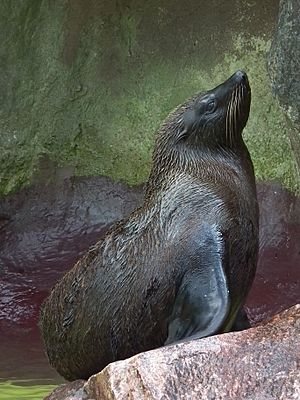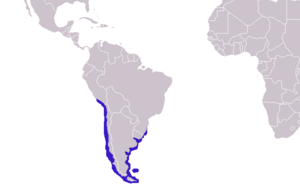South American fur seal facts for kids
Quick facts for kids South American fur seal |
|
|---|---|
 |
|
| South American fur seal at Zoo Landau | |
| Conservation status | |
| Scientific classification | |
| Genus: |
Arctocephalus
|
| Species: |
australis
|
 |
|
| Distribution of South American Fur Seal | |
The South American fur seal (Arctocephalus australis) is a cool marine mammal that lives along the coasts of South America. These seals are known for their thick fur and their playful nature. You can find them breeding on beaches and rocky shores in countries like Peru, Chile, Argentina, Uruguay, and Brazil, as well as on the Falkland Islands. They are a type of fur seal, which means they are related to sea lions and other seals.
Contents
All About the South American Fur Seal
South American fur seals are fascinating animals that spend most of their lives in the ocean but come ashore to rest, breed, and raise their young. They are part of a group of animals called pinnipeds, which means "fin-footed." This group includes seals, sea lions, and walruses.
Where They Live
South American fur seals live along the coasts of South America. Their main homes are in countries such as Peru, Chile, Argentina, Uruguay, and Brazil. They also live on the Falkland Islands, which are off the coast of Argentina. These seals prefer rocky shores and islands where they can find safe places to rest and have their pups. They often gather in large groups called colonies.
What They Look Like
South American fur seals are medium-sized seals. Adult males are usually larger than females. Males can weigh up to 200 kilograms (about 440 pounds) and be over 2 meters (about 6.5 feet) long. Females are smaller, weighing around 50 kilograms (about 110 pounds) and reaching about 1.5 meters (about 5 feet) in length.
They have a thick, two-layered coat of fur that helps keep them warm in the cold ocean waters. Their fur is usually dark brown or gray. They have visible ear flaps, which is a feature that sets them apart from "true seals." They also have long whiskers, called vibrissae, which help them feel their way around underwater and find food.
What They Eat
South American fur seals are carnivores, meaning they eat meat. Their diet mainly consists of fish, squid, and other small sea creatures. They are excellent hunters and can dive deep into the ocean to catch their prey. They use their strong flippers to swim quickly and gracefully through the water.
How They Live
These seals are very social animals. They live in large groups called colonies, especially during the breeding season. Males are very territorial during this time. They will fight with other males to protect their space and the females within it. Females also have their own social structures within the colony.
South American fur seals communicate using a variety of sounds. They bark, growl, and make other noises to talk to each other. They also use body language, like head movements and postures, to show how they are feeling.
Life Cycle and Pups
The breeding season for South American fur seals usually happens in the spring and summer months. Males arrive first at the breeding grounds to establish their territories. Females arrive shortly after.
- Birth: A female seal gives birth to one pup at a time. The pups are born with a dark, soft fur coat.
- Nursing: The mother seal nurses her pup for several months, feeding it rich milk that helps it grow quickly. During this time, the mother will go out to sea to hunt for food and then return to her pup.
- Growing Up: Pups learn to swim and hunt from their mothers and other seals in the colony. They gradually become more independent.
- Lifespan: South American fur seals can live for about 15 to 20 years in the wild.
Protecting These Seals
The South American fur seal is currently listed as a species of "Least Concern" by the International Union for Conservation of Nature (IUCN). This means their population is stable and not currently at high risk of extinction. However, like many marine animals, they can face threats from human activities.
- Fishing: Sometimes, seals can get caught in fishing nets, which can harm them.
- Pollution: Ocean pollution, like plastic waste, can also be dangerous for seals.
- Climate Change: Changes in ocean temperatures and food sources due to climate change could also affect their populations in the future.
Scientists and conservation groups work to monitor these seals and protect their habitats. This helps ensure that South American fur seals continue to thrive in their ocean homes for many years to come.
See also
 In Spanish: Lobo marino de dos pelos para niños
In Spanish: Lobo marino de dos pelos para niños


